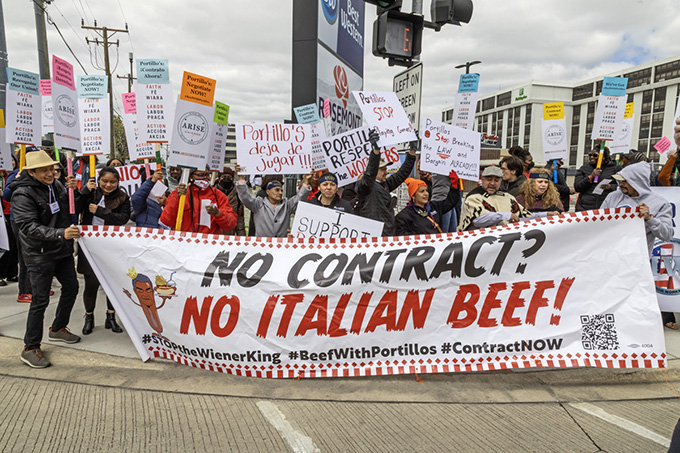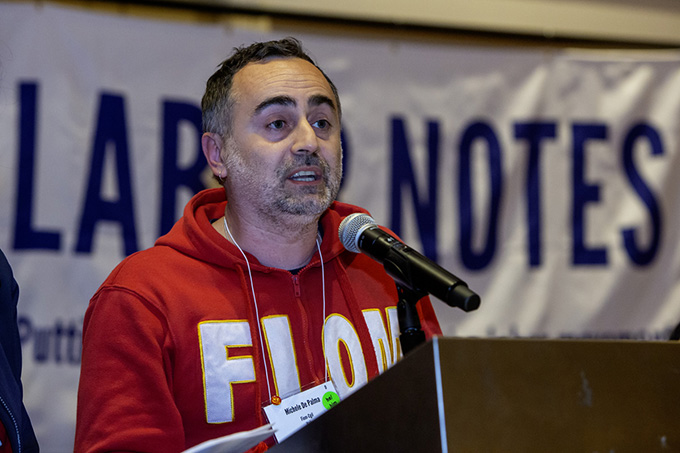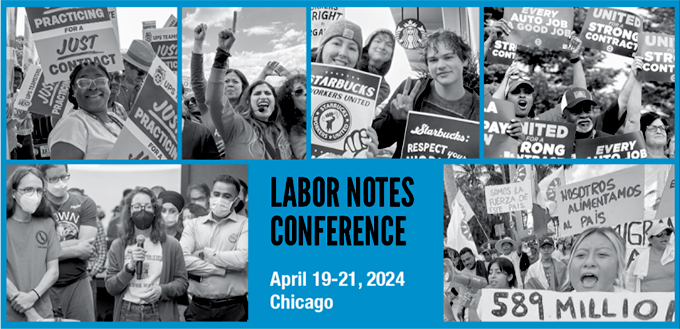Good news from the U.S.: the “American Lessons” from the Labor Notes Conference 2024
By Salvo Leonardi
On Friday PM April 19 I was scheduled to chair a Labor Notes workshop on “Organizing in the Construction Industry” I entered the designated hotel meeting room and approached the table in front to begin set up. I heard a vibrant Italian speaker and engaged with him. Turned out it was Salvatore Leonardi from the Confederazione Generale Italiana del Lavoro – CGIL. He had been a panelist for a discussion of international trade union solidarity. Later I met up with him in the lobby of the O’Hare Hyatt as he headed to Chicago to explore labor history and blues clubs. His solid knowledge of both genres really impressed me. His appreciation for the Windy City was amazing, and I vowed to stay in touch and meet up with him on my next visit to Italia. Soon after my return from Chicago Salvo posted an article he had written about Labor Notes. The article was impressive for its reflections from the perspective of one of the most advanced labor confederations in the industrialized world. I thought it should be published in the USA. The Forum is proud to publish the article in English. And of course, we thank Salvo for permission to publish and his excellent translation. Peter Olney, Stansbury Forum co-editor
“American Lessons” From the Labor Notes 2024 Conference
In recent times there is great ferment on the American trade union scene and it is full of energy and optimism. After decades of setbacks, defeats and disappointments, the world of work in the USA seems to have taken another path, changing the ideological range and organizational practices of the old accommodating “business unionism”, and consequently going on the offensive. This occurs on the basis of a tactical and strategic plan, which has been at the center of US trade union planning for some years, under the banner of a radical, bottom-up social movement unionism, the echoes of which we too have felt in Italy in terms of “organizing” and union reform, for example.

In 2023, more than half a million American workers went on strike, winning average wage increases of 6.6%. These are just some of the concrete examples of this phase of change:
- The recent sensational victories against the three auto giants (Ford, GM and Stellantis)
- The unionization of a large plant in the anti-union deep South (Volkswagen of Chattanooga, Tennessee)
- The paralysis imposed by actors and authors, until victory, in the world of Hollywood
- The unionization of 10,000 employees in 400 Starbucks coffee shops, as well as among the warehouse workers and drivers of UPS and Amazon, in Staten Island (NYC)
- The 25% wage increase in fast food restaurants in California
- Various victories of educators and academic workers
Part of making this possible – to give them their due – is this peculiar network “Labor Notes”(LN). Both an editorial and political-union elaboration, LN was born in 1979, on the initiative of a group of trade union militants and radical left socialists. It first took the form of an information and struggle magazine, publishing some handbooks, two being “Secrets of a Successful Organizer” and the “Troublemakers Handbook”. The latter handbook was a text that the current President of the renewed automotive workers’ union (UAW), Shawn Fain, has defined as nothing less than his secular “Bible” as an activist, inspiring him in the radical renewal with which he first climbed the ranks of the organization, and then guided it – in these last two years – towards goals that would have seemed unthinkable, until now.
But Labor Notes is also a Conference that is organized every two years, with continuous and exponential growth between one edition and another. April 19-21 saw as many as 4,700 grassroots delegates and trade union officials converge on a big hotel in Chicago from all over the United States. There was also representation from various other countries, including some of us – from FIOM and FDV-CGIL – brought together to discuss, exchange experiences and ideas in almost 300 workshops on trade union and industrial relations topics. This was a very interesting format due to its extremely pragmatic, operational, horizontal and decentralized character. Aimed at achieving maximum valorization and comparison between fighting practices conducted, mostly in single production units, it was a search for the most effective and successful tools and methods. The key to this grassroots unionism lies in the connection that can and must be built between organizing – understood as the ability to represent the unorganized – conflict, and collective bargaining aimed at an agreement truly full of improvements reflected in wages, and general working and living conditions. The workshops began with short keynote speeches and many concrete experiences shared to be passed on to network and establish contacts.
With just a couple of moments in plenary, at the beginning and at the end, the conference was a very dense program that lasted late into the evenings. Moments of leisure, and musical or theatrical performances, produced an atmosphere of great effervescence, because of the extraordinary presence of young and very young people. Children and grandchildren of that “Other America”, which has now powerfully returned to the international political and media scene, thanks to the pro-Palestine mobilizations on many university campuses. The keffiyeh was, even in Chicago, a dominant symbol placed on t-shirts and organizational jerseys: UAW, Teamsters for a Democratic Union (TDU) or teachers, flight attendants, Amazon, UPS or Starbucks employees.
“How to overcome the apathy of your colleagues?”, “Overcoming workplace divisions”, “You can’t do it all yourself: learn it, do it”, “Planning for a strike”, “Before, during, and after negotiations: step-by-step strategies”. These were just some of the titles of the many workshops that each participant could choose to go to and listen and speak out in. They often sang in the halls of the Hyatt Hotel, and sometimes it almost seemed like attendance at a session of collective self-awareness, as when a workshop discussed “What to do when your union breaks your heart?”. But there were also presentations about history, as in the workshop about Socialists at work, or on the legendary figure of Walter Reuther, leader of the UAW during the “Thirty Glorious” years, from 1946 to 1970.
What was striking, at least from an Italian viewpoint, was the almost total lack of speeches and debates regarding the current political situation. Both with respect to the Biden presidency – which had initially proclaimed itself to be the most pro-union since Lyndon Johnson’s times, and which was supportive of the autoworkers during their three-week strike – and with respect to the risk, although clearly perceived as catastrophic, of a new Trump victory. Politics, conventionally understood, was simply the great absentee of the three days in Chicago. The reason can probably be found in the idea – typical in the USA – that workers and their union representatives must first know how to do it themselves. Meaning being able to face and seek the solution to their problems with their own strength, without placing too many expectations on the policies of “friendly” governments or diverting forces and energies into an unequal clash with hostile executives. The structurally decentralized character of the U.S. state, as well as of the trade unions and North American industrial relations, has evidently contributed to this. Collective action has always had to deal with the deliberate cumbersomeness of the procedures for accessing representation in the workplace, and – above all – with the virulent hostility of employers to union recognition, representation and collective bargaining.
There are many States where, in the name of a misunderstood (and legally sanctioned) “right-to-work,” employers can do everything they wish to ostracize requests for representation and strikes, including the systematic use of scabs. The bosses are therefore the first and true target of trade union action; and only secondarily does state power become the target. The inter-sectoral dimension: class, gender and race are intertwined. Yet research, discussion and mobilization are not dispersed in a thousand streams but are, as they say, “focused”, on the concrete possibilities that the trade union movement can realistically translate into conquests. A well-known orientation, however, since the times in which Selig Perlman, Samuel Gompers or Walter Reuther defined the theoretical outlines for the AFL-CIO. This had significant repercussions also on the Italian trade union scenario, traditionally skeptical in its left-wing towards that “trade unionism”, stigmatized by Lenin, to be ideologically weak (more job consciousness, than class consciousness). This theory was learned and translated by the greatest master of Italian labor law, Gino Giugni, who had discovered it in the 1950s, during his Fulbright at the University of Wisconsin, Madison. With his special doctrine on collective autonomy and auxiliary legislation, as the 1935 Wagner Act, which inspired the Italian Workers’ Statute of 1970, largely edited by the Giugni, at the time adviser of the socialist Ministry of Labor. Today that old and classic “voluntarist” matrix lives again in a radical sauce, as it did in our “hot” 70s keeping its distance from those bureaucratic and collaborationist encrustations that we had known at the time when Marchionne of FIAT, in Detroit, embraced the UAW leaders and extolled their virtues and exemplary values to their Italian colleagues. A piece of that UAW union leadership – let it be said here – came to an end following scandals and convictions for the corruption of having exchanged concessions for personal gain at the expense of workers.
Today the UAW wins again and does it in a big way as beacon of hope offering a model for everyone. The union proclaimed, and successfully concluded, three weeks of strike:
- With resistance funds capable of covering 500 dollars a week, for each striker (when will we reflect on this instrument profitably used by many unions abroad?)
- Increases of 25% in four and a half years (+11% immediately)
- Re-introduction of the so-called “COLA” (cost-of-living-adjustment)
- End of the two-tier regime, depending on professional seniority
- Increase in the starting hourly wage, from 16.25 dollars to 22.50
- And even a reimbursement of 110 dollars a day, lost during the strike pickets.
The agreement passed with large majorities in all the plants that voted on it. Victories, in trade union matters, are fundamental and contagious. “We have finally ended 40 years of concession bargaining. It’s the best contract of my entire life”, testifies an elderly GM union officer. The success against the Big Three of the automakers sparked a chain reaction. With a roar in the room, on Friday the 19th of April, the news of the victory in the vote, held at Volkswagen of Chattanooga, was welcomed, with 73% in favor of finally allowing the union to represent the 4,300 employees of the plant, after two attempts failed in the recent past.
In Chicago there was a large representation of trade union delegations from various countries; obviously Mexico – around fifty workshops were in Spanish, because of the strong presence of Latino workers. There were also significant delegations from Japan, South Korea and Europe: Unite, from the United Kingdom, the secretary of the German ver.di in person, Yanira Wolf,together with various exponents of IG Metall and the Rosa Luxemburg Foundation. The Swedish IF Metall was there to talk about the strike at Tesla (did you know that that union has one and a half billion euros – you read that right – in strike funds?) Italy was represented by the CGT and, for the CGIL, a delegation from FIOM and your author, for the Fondazione Di Vittorio (the CGIL institute of economic and social research), to report in an international workshop on a series of experiences of struggle carried out by the CGIL, in recent years.

The speech given by Michele De Palma, General Secretary of the metalworkers federation (FIOM-CGIL) aroused great interest, and enthusiasm. He spoke in the final plenary on Sunday morning, about our common struggles alongside the star of the whole event, the UAW’s Shawn Fain, who closed the conference. His rise to the presidency of the UAW, two years ago, was made possible thanks to the campaign of its most radical faction: the Unite All Workers for Democracy (UAWD). Their rejection of any bureaucratic and collaborationist drift, their promotion of militancy and democracy from below, and an offensive strategy, produced a foundational strategy that did not take long to produce its fruits. Starting with the contract for the Three Bigs Fain’s pose and prose are all a tribute to the class imagery of his people. And, in those rooms, he pronounces highly effective phrases, which warm the heart and generate a contagious enthusiasm. The concepts, already expressed in recent speeches reported on in the “Labor Notes” magazine sounded more or less like this:
“We are here to put an end to business unionism, endless concessions, union corruption and the shackles that have bound us. I have said many times that negotiating good contracts leads to good success, even on an organizational level. These are two things that go hand in hand. From this point of view, our strike was not only against the “Big Three”. It belonged to the entire working class. And it is proof of one thing: that the working class can win. It can change the world. We don’t win by playing defensively or by always just reacting to things. We don’t win by being nice to the bosses. We don’t win by telling our members what to do, what to say, or how to say it. We win by giving working class people the tools, inspiration and courage to stand up for themselves. From this point of view, I think, that the working class represents the arsenal of democracy, and that the workers are the liberators”.
When Shawn Fain finished his remarks, paraphrased above, the big hall of the hotel was rocked by a chorus of applause and chants at the end of this heartfelt speech. In the end he proposed to organize a united general strike on May 1, 2028; date on which the UAW collective agreement with the automotive “Big Three” will expire.
Yes; the data on unionization do not show any significant changes, union density remains a modest 10% only thanks to the strong contribution of public employees (33%) – and there could be serious repercussions if a Trump election were to result in an entirely pro-employer composition, within the crucial National Labor Relation Board (NLRB). But for now that audience of fierce and enthusiastic trade union activists enjoyed this moment of unexpected successes, after the many, too many disappointments of the past years.
There is a beautiful sunrise in Chicago, we will soon see whether it is the sign of a new and lasting spring for the American trade union movement. Let us hope that these recent conquests will speak and reverberate here in Italy too for the work and the fight that awaits us. But here in Chicago, we have seen conference methods which, due to the organizational format and – above all – the content of the approaches, it would be useful for us to scrutinize by adopting the best spirit of comparison and mutual and emulative learning.
…
